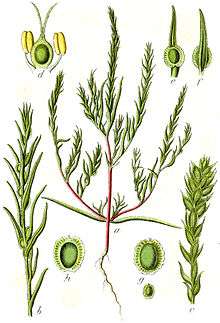Corispermoideae
The Corispermoideae are a subfamily of the Amaranthaceae, formerly in family Chenopodiaceae.
| Corispermoideae | |
|---|---|
 | |
| Corispermum marschallii | |
| Scientific classification | |
| Kingdom: | Plantae |
| Clade: | Tracheophytes |
| Clade: | Angiosperms |
| Clade: | Eudicots |
| Order: | Caryophyllales |
| Family: | Amaranthaceae |
| Subfamily: | Corispermoideae Ulbr. |
| Genera | |
|
3 genera; see text | |
Description
The species of the subfamily Corispermoideae are all annual plants. Leaves are mostly alternate, sessile or petiole-like attenuate, laminate, scleromorphic. Typical are branched (dendritic) trichomes (except in Anthochlamys) on young plant parts.
The flowers are arranged in simple, compact (sometimes globular) partial inflorescences, or in spikes. Bracteoles are missing. The perianth consists of 1-5 white, membranaceous tepals (missing in some Corispermum species) without vascular bundles, not persistent. The pollen grains of Agriophyllum and Corispermum are of the "Chenopodium type", of Anthochlamys of the "Anthochlamys type".
The fruits possess supporting tissue consisting of macrosclereids. The seeds have a vertical embryo and copious perisperm.[1]
Distribution
The subfamily Corispermoideae is distributed in Asia, Europe and North America.[2]
Photosynthesis pathway
All species studied show non-Kranz corispermoid leaf anatomy and C3 photosynthesis.[2]
Taxonomy
The tribe Corispermeae was published in 1840 by Alfred Moquin-Tandon (in Chenopodearum Monographica Enumeratio, Loss, Paris, S. 182). Oskar Eberhard Ulbrich raised it to subfamily level named Corispermoideae in 1934 (in Chenopodiaceae, S. 379–584 in Adolf Engler & Karl Anton Eugen Prantl (Edt.): Die natürlichen Pflanzenfamilien, Band 16 c, Engelmann, Leipzig).
Molecular data support the monophyly of the subfamily.[2]
It contains only one tribe:
- Tribus Corispermeae, with 3 genera:
- Agriophyllum M.Bieb., with 6 species in Asian regions with arid climate
- Anthochlamys Fenzl., with 2 species in Asian regions with arid climate
- Corispermum L., with at least 65 species in extratropical regions of Eurasia and North America[3]
References
- Alexander P. Sukhorukov: Fruit anatomy and its taxonomic significance in Corispermum (Corispermoideae, Chenopodiaceae). – Willdenowia 37, 2007, ISSN 0511-9618, p.63-87, doi:10.3372/wi.37.37103, (pdf)
- Gudrun Kadereit, Thomas Borsch, K. Weising, and Helmut Freitag: Phylogeny of Amaranthaceae and Chenopodiaceae and the evolution of C4 photosynthesis. - Int. J. Plant Sci. 164(6): p.959–986, 2003.
- Juan Juan Xue & Ming Li Zhang: Monophyly and infrageneric variation of Corispermum L. (Chenopodiaceae), evidence from sequence data psbB-psbH, rbcL and ITS, In: Journal of Arid Land, Volume 3, Issue 4, 2011, p. 240−253. doi:10.3724/SP.J.1227.2011.00240 Fulltext-PDF.
External links
| Wikispecies has information related to Corispermoideae |
- Chenopodiaceae, p. 72 und p. 73 Georg Volkens: Cyclolobaeae-Corispermeae in Adolf Engler & Karl Anton Eugen Prantl: Die Natürlichen Pflanzenfamilien, 3., 1893.